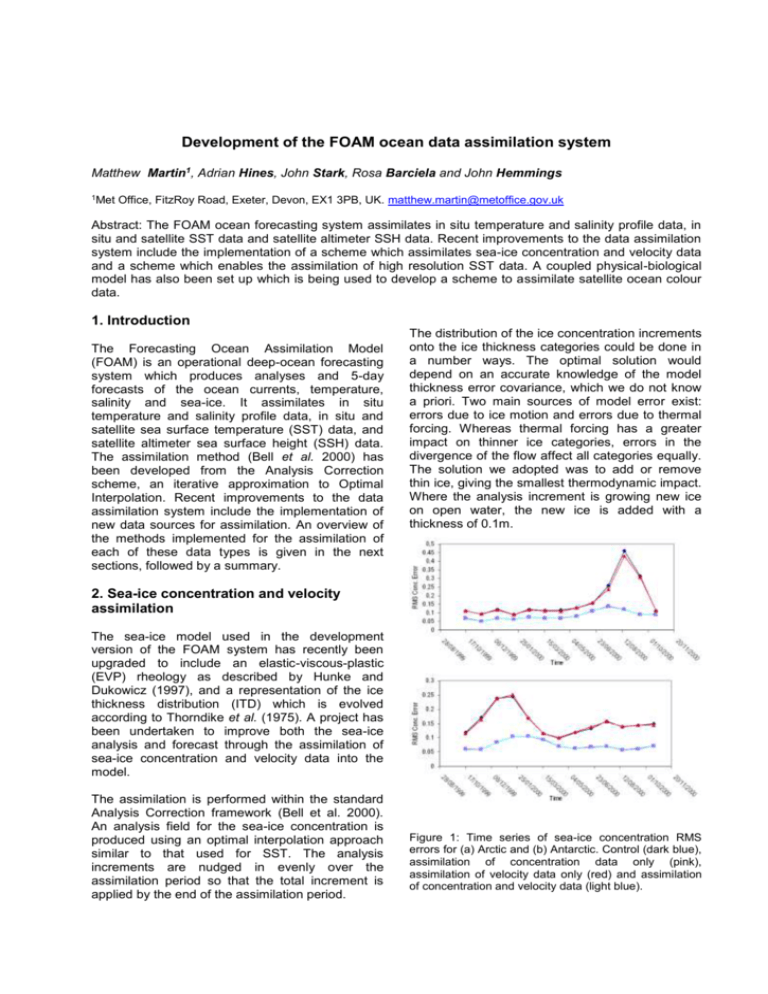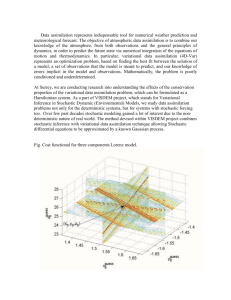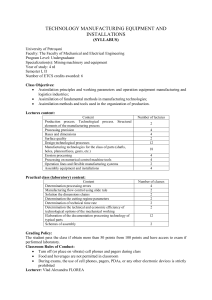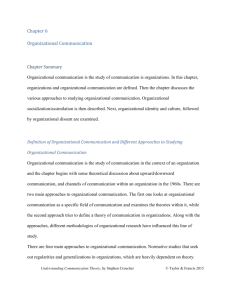Assimilating data into models with systematic errors
advertisement

Development of the FOAM ocean data assimilation system Matthew Martin1, Adrian Hines, John Stark, Rosa Barciela and John Hemmings 1Met Office, FitzRoy Road, Exeter, Devon, EX1 3PB, UK. matthew.martin@metoffice.gov.uk Abstract: The FOAM ocean forecasting system assimilates in situ temperature and salinity profile data, in situ and satellite SST data and satellite altimeter SSH data. Recent improvements to the data assimilation system include the implementation of a scheme which assimilates sea-ice concentration and velocity data and a scheme which enables the assimilation of high resolution SST data. A coupled physical-biological model has also been set up which is being used to develop a scheme to assimilate satellite ocean colour data. 1. Introduction The Forecasting Ocean Assimilation Model (FOAM) is an operational deep-ocean forecasting system which produces analyses and 5-day forecasts of the ocean currents, temperature, salinity and sea-ice. It assimilates in situ temperature and salinity profile data, in situ and satellite sea surface temperature (SST) data, and satellite altimeter sea surface height (SSH) data. The assimilation method (Bell et al. 2000) has been developed from the Analysis Correction scheme, an iterative approximation to Optimal Interpolation. Recent improvements to the data assimilation system include the implementation of new data sources for assimilation. An overview of the methods implemented for the assimilation of each of these data types is given in the next sections, followed by a summary. The distribution of the ice concentration increments onto the ice thickness categories could be done in a number ways. The optimal solution would depend on an accurate knowledge of the model thickness error covariance, which we do not know a priori. Two main sources of model error exist: errors due to ice motion and errors due to thermal forcing. Whereas thermal forcing has a greater impact on thinner ice categories, errors in the divergence of the flow affect all categories equally. The solution we adopted was to add or remove thin ice, giving the smallest thermodynamic impact. Where the analysis increment is growing new ice on open water, the new ice is added with a thickness of 0.1m. 2. Sea-ice concentration and velocity assimilation The sea-ice model used in the development version of the FOAM system has recently been upgraded to include an elastic-viscous-plastic (EVP) rheology as described by Hunke and Dukowicz (1997), and a representation of the ice thickness distribution (ITD) which is evolved according to Thorndike et al. (1975). A project has been undertaken to improve both the sea-ice analysis and forecast through the assimilation of sea-ice concentration and velocity data into the model. The assimilation is performed within the standard Analysis Correction framework (Bell et al. 2000). An analysis field for the sea-ice concentration is produced using an optimal interpolation approach similar to that used for SST. The analysis increments are nudged in evenly over the assimilation period so that the total increment is applied by the end of the assimilation period. Figure 1: Time series of sea-ice concentration RMS errors for (a) Arctic and (b) Antarctic. Control (dark blue), assimilation of concentration data only (pink), assimilation of velocity data only (red) and assimilation of concentration and velocity data (light blue). Passive microwave satellite derived sea-ice concentration data have been assimilated for a one year integration. The resulting sea-ice concentration errors in the Arctic are presented in Figure 1. These show that the assimilation has some success in bringing the modelled sea-ice closer to the observations (as represented by the HadISST analysis). The assimilation revealed some significant biases between the model and observations in some regions. accuracy but affected by cloud) satellite measurements which are processed by Medspiration. The level 2 processed observations are assimilated by the FOAM system. Figure 3 shows examples of AMSR-E and SEVIRI observations for one day. Other sensors include AVHRR, TMI and AATSR. Sea-ice velocity data has also been assimilated using an algorithm which alters the effective wind stress on the ice. Using the velocity components as control variables, the ice velocity observations are assimilated using a multivariate method described by Daley (1991). By introducing correlations between the velocity components the amount of divergence can be controlled. The velocity increments calculated in this way are then used to produce a change to the stresses which are applied to the ice. Overall, the assimilation improves the representation of the ice motion, both in the analysis, as shown in Figure 2, and in the forecast. 0.14 Ice Velocity Comparison (North) RMS Error (m/s) 0.12 0.1 0.08 0.06 0.04 0.02 0 Nov-99 Jan-00 Mar-00 May-00 Jul-00 Sep-00 Nov-00 Figure 2: RMS differences between the FOAM test runs and IFREMER ice observations. There are no IFREMER observations from May to September due to the melt season. Control (dark blue), assimilation of concentration data only (pink), assimilation of velocity data only (red) and assimilation of concentration and velocity data (light blue). 3. High resolution satellite SST data assimilation Medspiration is an ESA funded project (www.noc.soton.ac.uk/lso/medspiration) to produce SST products at high resolution and accuracy for the Atlantic as part of the GODAE High Resolution SST (GHRSST) Pilot Project. As part of the testing phase of this project, the FOAM system was set up to assimilate the data from Medspiration on a daily basis. The data includes microwave (low resolution and accuracy, good coverage) and infrared (high resolution and Figure 3: Data coverage for 1st Feb 2005 for (a) AMSR-E (1306768 observations) and (b) SEVIRI (1712698 observations). A parallel version of the operational 1/9˚ north Atlantic FOAM system was run which assimilated the Medspiration SST data in place of the satellite data used in the operational system (2.5˚ AVHRR data). Figure 4 shows a comparison of the current system and the parallel system against in situ SST data. Both the mean and RMS errors are improved using the new data. The assimilation scheme requires further tuning before the maximum benefits of these data are realised. Figure 4: (a) Mean and (b) RMS errors of 24 hour forecast vs in situ SST data in the north Atlantic for a run assimilating low resolution data (red) and high resolution data (blue). 4. Assimilating satellite ocean colour data As a part of the Centre for observation of Air-Sea Interactions and fluXes (CASIX) project (www.pml.ac.uk/casix), work is underway to improve estimates of air-sea fluxes of CO2 by embedding the HadOCC ecosystem model (Palmer and Totterdell, 2001) into the FOAM system and by assimilating satellite ocean colour data. A global version of FOAM-HadOCC has completed an annual cycle starting February 2000 without assimilation of ocean colour data. Figure 5 shows some examples of the surface chlorophyll from the model run (top), together with data from SeaWifs in the north east Atlantic (bottom) for 3 different weeks in March, which coincide with the onset of the spring phytoplankton bloom. As part of the development of an ecosystem data assimilation scheme, a one-dimensional test bed version of HadOCC forced by FOAM data has been set up. This assimilates surface measurements of log(Chlorophyll) as part of an identical-twin experiment. Figure 5: (a) Modelled and (b) observed chlorophyll data, March 2000. Balancing increments are applied to the unobserved variables in the ecosystem model in such a way that carbon and nitrogen are conserved locally. In this way, the scheme aims to correct errors associated with incorrect partitioning of material between carbon and nitrogen pools. The increments are determined from a tunable error covariance model with temporal variations dependent on the biological model dynamics. concentration and velocity data from satellites has been shown to produce much improved analyses and forecasts. Assimilation of high resolution satellite SST data also has a positive impact over assimilating only low resolution data, although more work is needed to realize the full benefits of this data source. An improved description of the ocean ecosystem is also being sought via assimilation of ocean colour data into a coupled physical-biological model. Acknowledgements: This work was partially supported by funding from the European Space Agency (ESA) under contract number 17334/03/NL/FF. References: Figure 6: Results from a 1D test bed assimilating log(chlorophyll) data. 5. Summary A number of recent developments to the FOAM ocean data assimilation system have been described. The assimilation of sea-ice Bell, M.J., Forbes, R.M. and A. Hines. Assessment of the FOAM global data assimilation system for real-time operational ocean forecasting. J. Mar. Syst., 25, pp. 1-22, 2000. Hunke, E. and J. Dukowicz. An elastic-viscous-plastic model for sea ice dynamics. J. Phys. Oceanogr., 27, 1849-1867, 1997. Palmer, J.R. and I.J. Totterdell. Production and export in a global ocean ecosystem model. Deep-Sea Research I, 48, 1169-1198, 2001. Thorndike, A., D. Rothrock,G. Maykut and R. Colony. The thickness distribution of sea ice. J. Geophys. Res., 80, 4501-4513, 1975.






